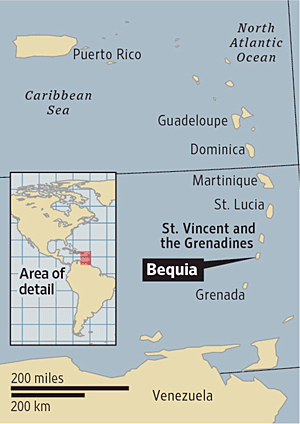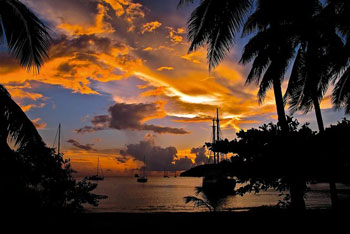Class News
Doug Lea '64 and wife Julie on Bequia
A Move to the Caribbean
A Virginia couple starts a new life on the small island of Bequia
by Julie Lea
The Wall Street Journal
January 12, 2014

My husband Doug and I live on a tiny remote island, Bequia, in the eastern Caribbean. It's like living in a screen saver, the perfect picture of paradise: palm-fringed beaches, turquoise waters, rugged tree-covered hills, flowers everywhere, dramatic sunsets, the sounds of nature surrounding us. All the tropical clichés.
But even paradise isn't for everyone. Let me explain.
Bequia, 7 miles square, is the largest of the Grenadine Islands that are part of the British Commonwealth country of St. Vincent and the Grenadines. The island's population is about 4000, with an additional 1000 during high-tourism season from mid-December to Easter. Temperatures range from the low 70s to the upper 80s. We're south of the usual paths of hurricanes.
We came to settle here after increasingly lengthy visits over almost three decades. Our first glimpse of Bequia was from the deck of a 38-foot ketch. In January 1978, my husband and I, with our two boys, chartered a sailboat owned by friends. Even though we had previously sailed throughout the Virgin Islands, we were enchanted by the unspoiled beauty of Bequia, with its charming people and their simple, traditional lifestyles.
As an artist, I was drawn to the vibrant colors, the scenery, and the adventurous self-styled boat vagabonds, those world travelers living aboard their crafts full-time and cruising the open seas. I felt we had sailed into a Herman Melville novel. I wanted to record it all in words and paint.
Making It Home
On a visit in 2004, a friend showed us a derelict house, a 1960s vacation retreat in a remote section of the island called Spring. The place had been neglected for years. Termites had invaded the original cedar-shake roof. Still, the structure had beautiful bones. The American architects who designed it and the handful of other vacation retreats in the area were influenced by Frank Lloyd Wright.
At first, I wasn't thinking about moving overseas. For two decades, we had lived in, and loved, the village of Waterford, Va., about 50 miles from Washington. I worked as an artist and author; Doug was a writer based in Washington.
But traffic and development were encroaching upon our county. We had our children early in life. Our mortgage was paid off, and we were open for a new adventure.
In 2005, we decided to buy the house in Spring. We were both 63 years old. We restored the house and garden.
Today, I drive a mile and a half from our perch above the Atlantic — along roads filled with pedestrians, goats, dogs and often vehicles that have stopped in the road so their occupants can chat with passersby — to my studio near the town of Port Elizabeth. There I paint, write and offer classes for budding artists. I've also been involved in community projects, coordinating the delivery of art supplies and books from friends in the U.S. for elementary-school students here.

At the end of the day, I'm back up in the quiet hills of Spring, gardening and watching the colorful drama in the clouds and sky at sunset.
Doug has embraced photography and now has a collection of more than 10,000 pictures of Bequia life. He has taught himself how to build stone walls and steps that terrace our leeward hillside for an orchard and vegetable garden. He and his beloved island dog, Soda, hike every day along the vacant beaches and unpopulated "bush" to find dried seaweed and the manure from roaming cattle to build up the poor soil on our hilltop. When there is a need for "formal wear," he jokes, he just tucks his T-shirt into his cutoffs.
Patience and Humor
There are occasional nights out and lively meals with friends. Within a few minutes' drive are five picture-perfect beaches. There is a small community of expat homeowners living here year-round. Americans are the smallest group. There are a few more British and Canadians and a smattering of Germans, French, Swedes, Italians, and Spaniards. Many of us return to friends and family for a few weeks every summer, but we hurry back to enjoy the peace and empty beaches of low season.
Still, living here takes a special combination of self-reliance, tolerance, patience, and humor. There is no stoplight on the entire island, and no one seems to respond to the few tattered speed bumps and road signs. The roads are narrow and steep, flanked by deep, open rain gutters. There is only one gas station, and it is usually closed on Sundays, along with most of the small businesses in Port Elizabeth.
There are no shopping malls or chain restaurants, although there are plenty of charming, family-owned establishments. The only "fast food" available is from local people who serve up home-cooked meals outdoors or in tiny booths.
Everyone swelters in the hot, still months of August and September (and sometimes October). Mosquitoes, lizards, bats, and other critters are a fact of life here. And the sea, with its various creatures and mood swings, commands respect.
Reassuring, though, is the remarkable resilience and inventiveness of Bequians. Maintaining cars and equipment, repairing machinery, building houses and boats, installing plumbing, tackling masonry: These tasks and more are part of daily life. People here demonstrate both a determination to survive and an amiable acceptance of visitors.
Always an Adventure
Few foreigners opt to stay year-round. They spend only winters here, returning to other homes elsewhere. If you are planning to "come and go," as they say here, and are willing to accept the expense of maintaining a home in Bequia while you are away, I advise buying an existing villa and forgoing the twists and turns of building. Most household comforts Americans expect must be imported. (Bathtubs and unlimited hot water are rare.) Many longtime winter residents simply rent the same well-equipped villas for the season each year.
After securing a home here, most people find total monthly expenses to be low in comparison to the States. Frugal expats can live comfortably on less than $2,500 a month. We visit the open-air vegetable markets to buy fresh produce, much of it grown in the fertile volcanic soil of St. Vincent. Many residents take one of the daily ferries to "the mainland" of St. Vincent (an hour each way) to shop at larger supermarkets and hardware stores.
As for health care, there's a new clinic and, opening soon, a small hospital in Port Elizabeth. Medical attention is free for minor treatments, but expats usually leave a donation.
After seven years of living here, it still feels like we're just getting started. There's much to explore. There are 32 islands in the nation of St. Vincent and the Grenadines, most of them easily reached by chartered or public transportation.
Doug and I will never be like those true adventurers we first encountered here, the boat vagabonds, dropping anchor in remote places throughout the world. Still, every day is an adventure for us. It's wonderful to wake up year-round to sunshine, bird song, and the sounds of the ever-changing ocean below. We fall asleep to the bell-like chiming of tree frogs. We've discovered that a simple, reflective lifestyle allows for an overflowing of creative expression.
We take special joy in watching the drama of the West Indian skies filled with rainbows, glorious sunsets, and infinite stars. Living so close to nature, with our unscreened doors and windows open to the gentle trade winds almost every day, is an experience I've had only in Bequia.
It would be hard to give that up.
See some of Doug Lea's photographs of Bequia on our Visual Arts page.

